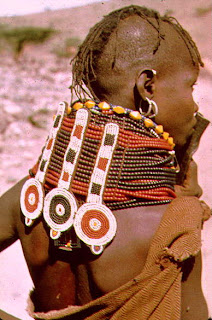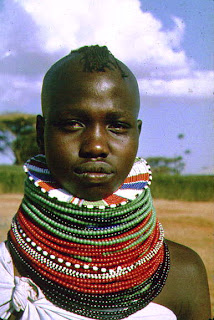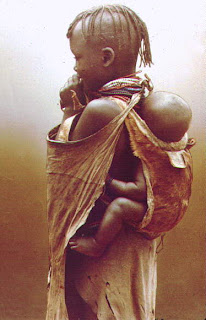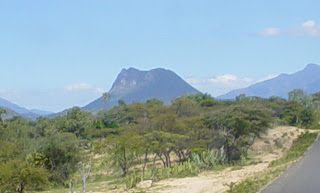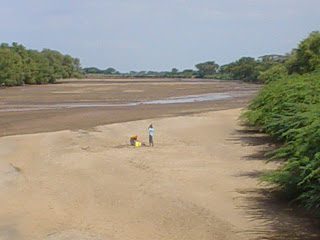 In December, I traveled to the area inhabited by the Turkana - a most interesting people group. It was such an incredible and memorable trip! I went with my good Kenyan friend, Kim. He and I both seem to have been stricken with a spirit of wanderlust!
In December, I traveled to the area inhabited by the Turkana - a most interesting people group. It was such an incredible and memorable trip! I went with my good Kenyan friend, Kim. He and I both seem to have been stricken with a spirit of wanderlust!
We saw everything that these photos depict. These people do currently dress this way. In fact, they seem to live in a sort of time warp.
Because I couldn't always get such good photos myself, I got these five photos off of the internet. You will see, as you read further, that they are a very warlike tribe. To say they don't appreciate having their photo taken would be an understatement! As a matter of fact, we had more than a couple of close calls when they saw my camera. Because of that, I was a very frustrated photographer! The scenes we saw that I couldn't photograph are many!
I hope you'll take the time to read what I've included about this fascinating people!  We saw numerous men with their hair fixed like this. They cover it with mud and paint it blue. It can stay that way for months. This guy is resting on a head stool. Virtually every man walks around carrying one of these.
We saw numerous men with their hair fixed like this. They cover it with mud and paint it blue. It can stay that way for months. This guy is resting on a head stool. Virtually every man walks around carrying one of these.
 You can see that this young man also has a head stool with him.
You can see that this young man also has a head stool with him. The other item that virtually every man walks around with is a walking stick, or fighting staff.
Notice the ostrich feather sticking up from his head.
This is a very common adornment for men.
 We saw numerous men and women with such piercings. Usually it was some sort of metal.
We saw numerous men and women with such piercings. Usually it was some sort of metal.
The women wear their hair in braided mohawks.
 The following information was taken from the website - bluegecko.org
The following information was taken from the website - bluegecko.orgWith a population around 300,000, the Nilotic-speaking Turkana are Kenya's second-largest group of pastoralists, after the Maasai.
The majority live in Turkana District of Rift Valley Province in the arid northwest of Kenya, near Lake Turkana (the world's largest desert lake) and its volcanic hills.
The land they inhabit, for the most part, is parched desert plain strewn with rusty sun-baked rocks, coarse sand and small outcrops, and some low and equally barren hills. The climate is dry and often blisteringly hot, and the paltry annual rainfall prevents any but the hardiest of desert plants from growing: spiny acacia, low thorn bush and seasonal grasses. In any case, rainfall patterns are unreliable and patchy; many years the rainfall is scant or fails altogether.
As a result of their hostile environment, in which drought plays a regular part, survival is very much the primary concern. Like the related Maasai, cattle are the primary wealth (although goats and camels are sometimes also kept), providing for almost all the Turkana's material and nutritional needs, as well as being symbols of social standing intricately bound into the tribal fabric.
And so the Turkana move constantly, chasing the clouds in the hope of rain and the small patches of freshly sprouted vegetation which it gives. As rainfall is uneven and unreliable, this can only be accomplished by the tribe fragmenting into small groups, for what there is of pasture is insufficient to feed a large number of livestock, and hence people.
Given the sparsity of grazing lands and cattle pastures, competition with neighboring tribes is fierce and relations are generally volatile, usually verging on warlike. There is a recurring cycle of raids and counter-raids over cattle in which rifles or automatic weapons are now primarily used. In general, it seems that the Turkana are more often instigators of such raids rather than victims, and as a result are feared by many.
Cattle raiding is not so much a 'mere' matter of pride and manliness for the Turkana, as it is for the Maasai. Rather, it is the necessity of guaranteeing one's own survival while weakening one's competitors, and is equally important in securing the wealth necessary to obtain a wife, for bridewealth payments are made in cattle.
Drought and hunger are a recurrent feature of life, and surviving them are what has made the Turkana who they are today: a proud, self-sufficient people, adept fighters and territorial expansionists, indifferent to the lures of 'progress' and change.
Way of life: The majority are cattle herders, though many also herd goats. Some have adopted the camel. A small minority, dispossessed of their herds in previous droughts, now engage in small-scale agriculture and fishing on Lake Turkana.
Religion: The vast majority have retained their traditional beliefs. 5-10% Christian, and then mostly only nominally.








